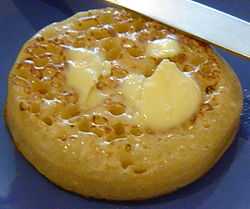Crumpet
| Crumpet | |
|---|---|
|
A buttered crumpet | |
| Type | Bread |
| Place of origin | England |
| Main ingredients | Flour, yeast |
|
| |
A crumpet ![]() i/ˈkrʌmpɨt/ is a griddle cake made from flour and yeast.
i/ˈkrʌmpɨt/ is a griddle cake made from flour and yeast.
Etymology
Crumpets are an Anglo-Saxon invention.[1] An early reference to them comes from English Bible translator John Wycliffe in 1382 when he mentions the 'crompid cake'. The early crumpets were hard pancakes cooked on a griddle, rather than the soft and spongy crumpets of the Victorian era, which were made with yeast.[2] The crumpet-makers of the English Midlands and London developed the characteristic holes by adding extra baking powder to the yeast dough. The term itself may refer to a crumpled or curled-up cake, or have Celtic origins relating to the Breton krampouezh / Cornish krampoeth[3] meaning a "thin, flat cake" and the Welsh crempog or crempot, a type of pancake.[4]
The English crumpet

English crumpets are generally circular roughly 8 cm (3") in diameter and 2 cm (0.8") thick. Their shape comes from being restrained in the pan/griddle by a shallow ring. They have a characteristic flat top with many small pores and a chewy and spongy texture. They may be cooked until ready to eat warm from the pan, but are frequently left slightly undercooked so that they may be cooled and stored before being eaten freshly toasted. They are often eaten with a spread of butter or some alternative spread on the top of them, such as jam, honey or yeast extract.
In the UK, Australia and New Zealand, branded square crumpets can be purchased from supermarkets, designed to fit easily in a standard toaster.[5]
A regional variation of the crumpet is the pikelet, whose name derives from the Welsh bara piglydd or "pitchy [i.e. dark or sticky] bread", later shortened simply to piglydd;[6][7] the early 17th century lexicographer, Randle Cotgrave, spoke of "our Welsh barrapycleds".[8] The word spread initially to the West Midlands, where it became anglicised as "pikelet",[9] and subsequently to Cheshire, Lancashire, Yorkshire, and other areas of the north.
The main distinguishing feature of the Welsh or West Midlands pikelet is that it was traditionally cooked without a ring, with an end result rather flatter or thinner than a crumpet.[6][10]
The term "pikelet" is also used in Australia and New Zealand for a similarly flat cake, of the type that in Scotland and North America would be called a pancake and in England a Scotch pancake, girdle or griddle cake, or drop scone.[11]
Scottish crumpet

A Scottish crumpet is essentially a pancake cooked in a slightly different way, made from the same ingredients as a Scotch pancake, and is about 180 mm (7 inches) diameter and 8 mm (0.3 inches) thick. They are available plain, or as a fruit crumpet with raisins baked in, and are not reheated before serving; they are usually served with butter and jam. The ingredients include a leavening agent, usually baking powder, and different proportions of eggs, flour and milk which create a thin batter. Unlike a pancake, they are cooked to brown on one side only, resulting in a smooth darker side where it has been heated by the griddle, then lightly cooked on the other side which has holes where bubbles have risen to the surface during cooking.[12] It bears little resemblance to the English crumpet.
This is the normal kind of crumpet in Scottish bakers' shops, tea rooms, and cafés, though the English type of crumpet is often obtainable in supermarkets in addition to the Scottish kind.
See also
References
- ↑ Ann Hagen, A Handbook of Anglo-Saxon Food Processing and Consumption, 1992, p.20
- ↑ John Ayto (18 October 2012). The Diner's Dictionary: Word Origins of Food and Drink. Oxford University Press. pp. 106–107. ISBN 978-0-19-964024-9.
- ↑ http://archaeologydataservice.ac.uk/archiveDS/archiveDownload?t=arch-408-1/dissemination/csv/Lexicon/Celtic_Lexicon_Cornish.csv
- ↑ Crumpet, Online Dictionary.
- ↑ Commercial website "Golden Crumpets"
- ↑ 6.0 6.1 Edwards, W. P. The Science of Bakery Products, Royal Society of Chemistry, 2007, p.198
- ↑ Luard, E. European Peasant Cookery, Grub Street, 2004, p.449
- ↑ The folk-speech of south Cheshire, English Dialect Society, 1887, p.293
- ↑ Wilson, C. A. Food & drink in Britain, Barnes and Noble, 1974, p.266
- ↑ Davidson, A. The Penguin Companion to Food, 2002, p.277
- ↑ The Concise Household Encyclopedia (ca. 1935) Fleetway House, The Amalgamated Press, London
- ↑ Traditional Scottish Recipes - Scottish Crumpets
External links
| Look up crumpet in Wiktionary, the free dictionary. |
| ||||||||||||||
| ||||||||||||||||||
